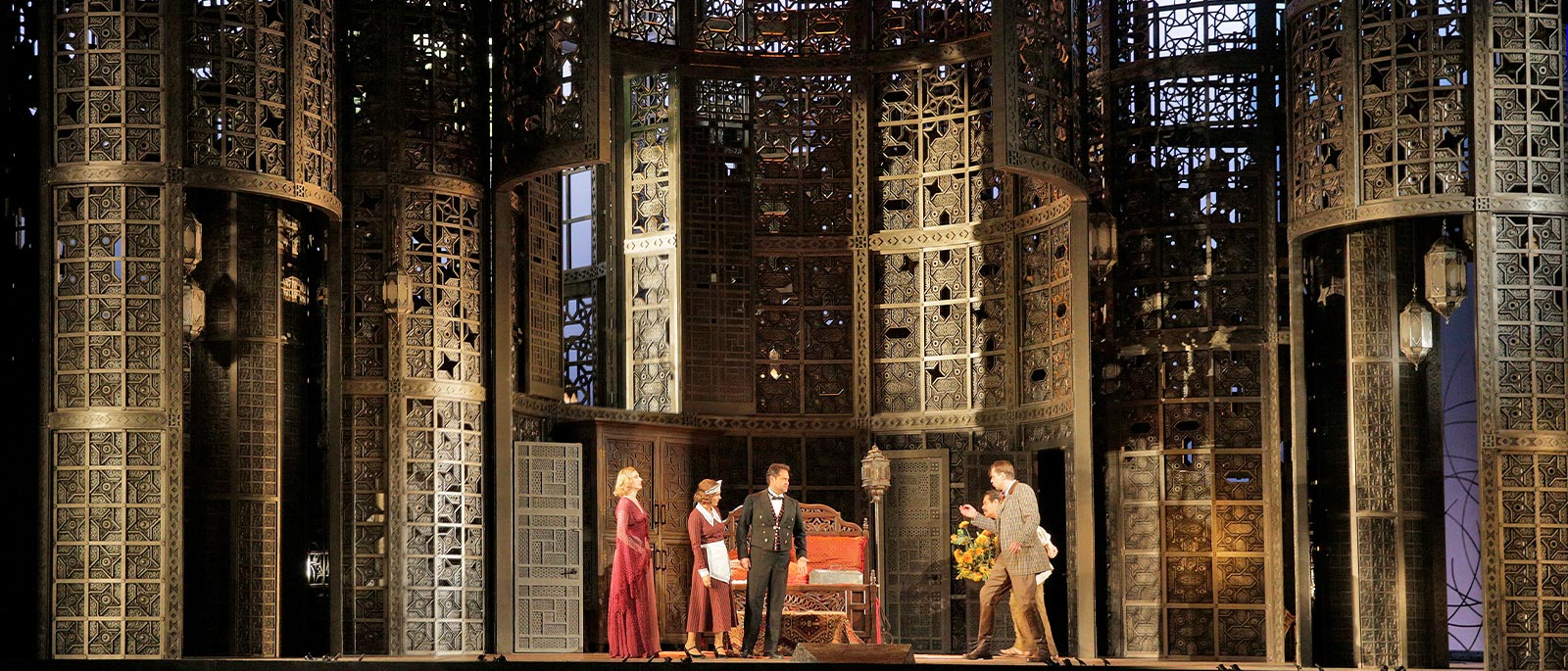
Golden Glow
In his new production of Le Nozze di Figaro, which premiered on Opening Night of the 2014–15 season, director Richard Eyre brought to the fore the sensuality of Mozart’s shimmering masterpiece. By Matt Dobkin
In Jean Renoir’s enormously influential 1939 film La Règle du Jeu, an estate in the French countryside serves as the backdrop for a story of marital discord, secret rendezvous, and illicit liaisons that cross class lines. The Rules of the Game, as it’s known in English, is a comedy, but one with a sharp satirical bent, dark underpinnings, and an ambiguous ending. The film was inspired by Beaumarchais’s La Folle Journée, the source for Le Nozze di Figaro.
For his 2014 new production of Mozart’s classic human comedy, director Richard Eyre, in turn, was inspired by Renoir’s film, setting the opera in an early1930s milieu that teems with sensuality. “The Marriage of Figaro is like very few operas in that it’s about sex,” Eyre declares. “There are a lot of pieces about romantic love—very few that are about sexual love. This is about desire, about attraction, and about the dividing line between love and lust. So I wanted to move it to a period that was enormously sexually charged, and that to me is the late 1920s, early 1930s. It’s just late enough to believe that there is a count who insists on exercising the droit de seigneur over the young girls in his employ.”
The sexual shenanigans were enacted by an extraordinary ensemble cast. Bass Ildar Abdrazakov sang Figaro, opposite soprano Marlis Petersen as his betrothed, Susanna. Baritone Peter Mattei was the licentious Count, and Met newcomer Amanda Majeski his anguished wife. Mezzo soprano Isabel Leonard rounded out the principal cast as the pageboy Cherubino.
Richard Eyre in rehearsal
Although Eyre moved up the time setting by about 150 years, the place remains the same: an 18th-century manor house in Seville. The director once again collaborated with set and costume designer Rob Howell, his creative partner on the Met’s recent productions of Carmen and Werther. Howell’s set for Figaro evoked the Moorish design influence still seen all over southern Spain via detailed paneling and lantern light that cast a shadowy glow across the proceedings. More importantly, the set is constructed on a turntable, with the rooms of the house represented by cylindrical towers of varying heights. As the turntable rotates, the audience will be able to follow the action from one room to the next uninterrupted, thereby enhancing the farce.
“I think audiences should look for a kind of fluency in the production that matches the music,” Eyre says. “The production moves—it has a sort of constant energy. We have corridors that lead from the Countess’s bedroom to the large hall where the wedding is going to take place—and then there’s the garden. I want to be able to go from one location to another completely fluently. It’s a great farcical machine. And I hope it has a kind of visual energy that matches the music.”
Costume designs by Rob Howell
If the set keeps the action powering ahead, the costumes emphasize the sexual force that constantly crackles throughout the evening. Susanna wears a slinky black-and-white maid’s uniform; the Count is clad in luxurious dressing gowns. The ambiguity of the trouser role of Cherubino appealed to Eyre in particular, especially when the young man (played by a young woman) takes off his military uniform to disguise himself as a girl and evade capture in the Countess’s bedroom. “It’s the most exquisitely sexy, naughty, and funny scene,” Eyre says. “And that element of transgressing sexual border lines runs through the piece.”
Indeed, Le Nozze di Figaro is today so well loved and such a central part of the operatic repertoire, it can be easy to forget how revolutionary and transgressive it was when it premiered in Vienna in 1786. If Beaumarchais’s original play was considered an even more scandalous depiction of society at the time, Figaro was nevertheless pioneering, thanks to its emphasis on the servant classes as the morally upright heroes of the story (at a time when most composers were still writing in the dramatic mode of earlier decades, with its focus on royalty from classical antiquity over everyday people).
Mozart’s brilliant librettist Lorenzo Da Ponte is due a considerable portion of the credit, as director Eyre points out. “One of the things I love about The Marriage of Figaro is that the score and the libretto are absolutely inseparable,” he says. “There’s a kind of detail of thought, emotion, and behavior in both the music and the words—it’s as if they were invented simultaneously. That’s what’s so exciting—the immediacy, the spontaneity. And it’s the job of the director and the conductor to make that spontaneity real.”
Matt Dobkin is the Met’s Creative Director, Content and Strategy.